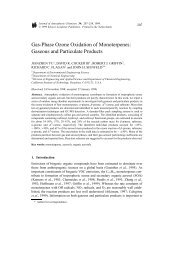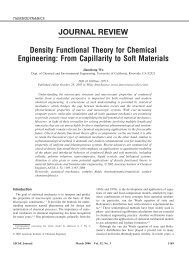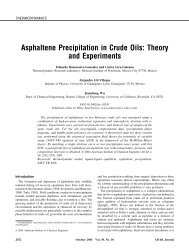DEVELOPMENT OF REVISED SAPRC AROMATICS MECHANISMS
DEVELOPMENT OF REVISED SAPRC AROMATICS MECHANISMS
DEVELOPMENT OF REVISED SAPRC AROMATICS MECHANISMS
Create successful ePaper yourself
Turn your PDF publications into a flip-book with our unique Google optimized e-Paper software.
Results<br />
Table 11 gives a summary of the average performance metrics for the simulations of the aromatic<br />
- NO x experiments with the updated aromatics mechanisms, with results shown for all compounds for<br />
<strong>SAPRC</strong>-11, the standard version of the mechanism, and shown also shown for <strong>SAPRC</strong>-11A for the four<br />
compounds where the additional NO x dependence incorporated in this version is necessary to fit the data<br />
over the full range of NO x levels. Average model errors are shown graphically, and compared between<br />
<strong>SAPRC</strong>-07 and <strong>SAPRC</strong>-11 on Figure 5 for all 17 aromatic compounds, and compared between <strong>SAPRC</strong>-<br />
11A and <strong>SAPRC</strong>-11 on Figure 6 for the four compounds where <strong>SAPRC</strong>-11A had to be used to fit the data<br />
over the full NO x concentration range. Table 11 gives the average biases and errors for the various<br />
metrics, where the biases are the averages of the model errors for the various runs and the errors are the<br />
averages of the absolute magnitudes of the model errors. The number of runs used for computing the<br />
Table 11. Average model performance metrics for <strong>SAPRC</strong>-11 model simulations of the aromatic -<br />
NO x chamber experiments.<br />
Compound<br />
∆([O 3 ]-[NO]) formation rate<br />
Maximum Integrated<br />
[NO x ]
















